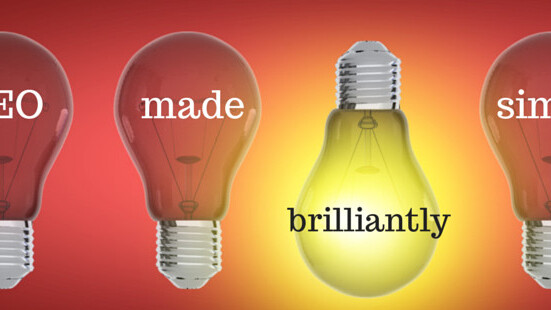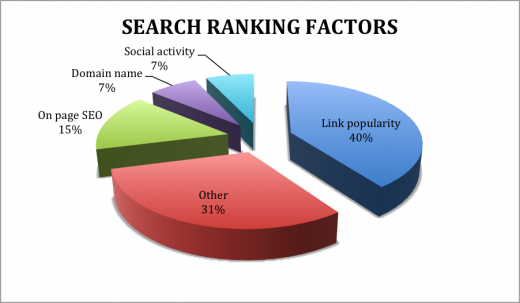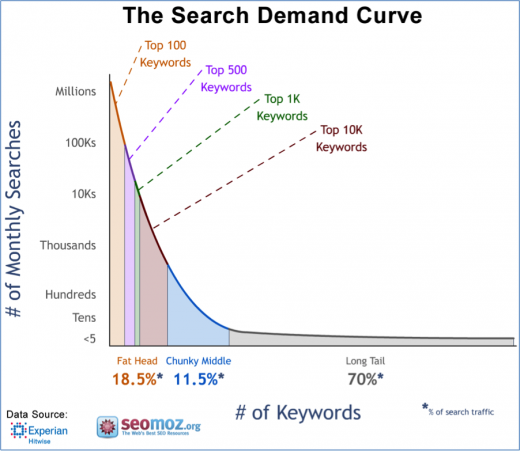
Barry Feldman is a content marketing consultant, copywriter, social media advisor and more. This post has been adapted from an original version on his blog, Feldman Creative.
“We really do want to understand SEO.”
I was on a conference call with a client who said that. And then:
“Let’s plan to have a 15 minute call where you can explain SEO to us.”
Gulp. Can SEO really be simplified to that extreme? Well, I do love a good challenge. But I don’t love SEO. I’m not the analytical type. If SEO isn’t exactly your cup of tea, here we go: SEO, with a spoonful of sugar.
(The article takes 15 minutes to read aloud and, of course, less to simply read.)
What does SEO mean?
Search engine optimization. It’s a clunky term for sure. You can’t optimize search engines. In fact, you can’t even learn exactly how they work. These are well-guarded secrets.
What can you do? You can do the right thing to your website’s pages—optimize them—to increase the likelihood Google and the other search engines know where they are and what they contain, so it will present them as a recommended resource when they match a search.
That’s not all you can do. It’s ground zero—what you have to do. And though you need to understand what you’re up against to do it well, this activity, defined as “onsite optimization,” is the easy part.
The other stuff you can do represents the hard, but more meaningful part. This other stuff happens “offsite.” I’m going to explain.
But for now, to answer the question, I’ll say SEO means the things you do onsite and off to help get presented by a search engine and discovered by its users.
Search engine rankings are largely based on popularity
Essentially, people turn to a search engine because they have a question. The search engine’s job is to offer a directory of potential answers.
To help you find the answer you seek, the search engine tries to calculate the relevancy of web pages. The more relevant the page, the higher it will rank in the results.
SEO boils down to indicating the relevance of your content to the search engines
To determine relevance, search engines use algorithms, massively complicated mathematical formulas written (and perpetually refined) to robotically determine what content is worthy of being presented in response to a search.
How’s it do this? Everyone would like to know the answer, but no one actually does. So they speculate. Test. Measure. And they attempt to tell, or sell, you highly informed theories.
But at a broad level, most can agree search engines base rankings on:
- The quality of the content and
- The popularity of the content (which is assumed to reflect the prior)
For a very long time, because it was possible to convince the search engine your site and its pages were relevant through the careful execution of sleazy and unethical tactics, a great big sleazy and unethical business exploded. It was called SEO.
Today, a great many SEO companies purposely steer the conversation in the direction of content marketing, a much less controversial subject. Why? Because content is the one thing that holds steady in search.
Understand the basic on-site and on-page signals
If you’re going to have a fighting chance to rank you need to abide by some ground rules. Essentially, you must setup your web pages such that they contain the basic elements search engines are capable of discovering.
You see, your website is “crawled” by “spiders.” That’s the metaphor, like it or not. The spiders seek out words—keywords—to create an index of the content offered on your pages.
Your challenge is to understand the proper places to put the keywords so the search engine understands the page’s content.
Title tag: Your title (and at the code level, “tag”) each page to tell the search engines what the page is about. Again, you do this with keywords. You need to choose them carefully and use them naturally.
You also should limit your titles to 60 characters (or so) so they are presented in their entirety.
The title above does not fit, though it ranks first for “content marketing consultant.”
A few spots below is a blog post on my website. The title fits, however an ellipse (…) shows because “Feldman Creative” follows.
This listing has no issues with length. Its challenge is it appears on the second search engine results page (SERP), where far fewer readers explore. (But note, the listing could very well appear on page one for a different search term.)
Your title tag (and all the tags we’ll review) belongs in a specific field in your HTML code. HTML is the language browsers and search engines understand. It may sound intimidating, but with some very basic training on using your content management system (CMS), you’ll understand exactly where to put each tag (and also get guidance regarding the appropriate length).
Keywords in the copy: Throughout the copy on your page, you’ll want to use keywords and variations of them. Do not overuse keywords for the sake of SEO. (Keyword stuffing can result in damaging penalties by search engines.)
However, consider the smart keyword placement tactics, which help to optimize your page:
- Use keywords near the beginning of the page’s copy.
- Use keywords and practical variations in your subheads. You’ll tag subheads with H2 and H3 designations in your HTML (H means “header”).
- Search engines are unable to “read” images, so when placing an image, take advantage of the “alt text” tag by giving the image a name, which includes a keyword.
- Use keywords once in the URL whenever possible.
Meta description: The role of a page’s meta description is to describe the page’s content. Meta descriptions are often misunderstood. They are not a part of the page optimization equation.
Still, they should be taken seriously because they affect the user’s decision to click or not. See, the search engine will often present the meta description you provide as the copy snippet displayed in your listing.
I searched for “meta description example.” The meta description above helps the reader understand the page’s content. Note the keywords used are bolded in the snippet. Also, meta descriptions are limited to 160 characters.
URLs: Your page’s URL should contain your keywords, but be as concise as possible. URLs are automatically generated based on the page title, so edit them to remove unnecessary words. Words in a ULR are separated by hyphens.
Internal links: Search engines aim to understand the structure of your site. It’s useful to create links within your copy to other pages on your site.
Using this practice may also serve to help your readers discover additional content and therefore, increase time spent on your site and have a better learning experience.
That’s it for on-page optimization. There’s no need to overthink or overdo it.
The keys to keyword selection
Though search engines are immensely powerful, they’re unable to read minds. Searchers must type or speak to the search engine. Basically, as a user, you feed the search engine words. In SEO, these are referred to as “keywords.”
Choosing keywords for your content is a critical first step in SEO. It’s important to recognize doing keyword research and selection effectively not only generates traffic to your site, it delivers the right kind of traffic—prospective buyers.
The smart money is on long tail keywords.
SEO only works when you select keywords for which you can achieve high rankings. But it’s not as simple as defining the obvious categories that describe your business. In addition to the relevance of your keywords, you must consider:
- Search volume—The number of people who search for the phrase in the geographic area you serve
- Competition—The websites already ranking for the phrase
When you begin doing keyword research, you’ll very quickly learn the short simple keywords you covet (usually one or two-word phrases) are impossibly competitive. The more competition you have, the less likely you’ll appear on the first page of search engine results page (SERP).
The reality is, the first page is the only page that matters because it earns an overwhelming majority of the clicks.
All hope is not lost. If you shift your strategy to long tail keywords—phrases of three or more words—you can find opportunities to rank on the first page and likely drive more qualified prospects to your web pages.
This chart depicts the long tail strategy.
- The y-axis shows search volume.
- The x-axis is the number of words in the search string (or keyword phrase).
- As the number of words in the search increase, the volume of search decreases.
- On the left side, searches for top keywords are searched in the millions, 100Ks, etc. These terms, commonly called “head” terms, are likely to be single words., e.g. SEO, baseball, convertible.
- The search volume decreases into the 100s in the “chunky middle,” where phrases are 2 or 3 words, e.g. SEO lessons, baseball stadiums, used convertible.
- The gray data set represents long tail phrases where search volume is measured in the 10s, e.g. SEO lessons for websites, baseball stadiums with domes, used Corvette convertible in Northern California.
- 70 percent of searches are for the long tail keyword phrases.
By targeting long tail keywords, you increase your chance to succeed as a “big fish in a small pond.” If you pursue the strategy for many long tail keyword phrases, you can generate significant traffic from search.
If your company does not operate a well-established, high traffic website with high authority, long tail keywords are the secret to your success with search.
Links reveal your website’s popularity
Though it’s commonly understood 200 or more variables are factors in determining the search engine ranking of a web page, the most important one is link popularity.

- Link popularity is based on the number of links from other websites to your page and also considers the authority or rank of the websites containing the links. The most trusted websites tend to link to other trusted websites.
- Other factors include metrics such as page load time, click through rates from search engines, search volume for the company, and the freshness of the content.
- On-page SEO is mostly attributed to the use and placement of keywords.
- Domain name refers to the use of keywords in your URL.
- Social activity is a hotly debated factor, but SEO professionals generally agree social activity applies (or at least correlates). Most say social signals from Google+ loom largest.
Andy Crestodina, a recognized expert from Orbit Media, explains, “It’s clear that links on other people’s websites are a big factor in how high you rank in search engines. If you’re serious about SEO, getting good links has to be a part of your content marketing efforts.”
After keyword research, link building is the next most important SEO activity. The most commonly useful and acceptable strategies to earn links (leading to higher relevance and ranking) include:
- Blogging—An informative and entertaining business blog is the most valuable SEO practice. The company can control what it publishes. Successful blogs not only populate the website with keyword-based content, but earn links from other blogs and websites.
- Great content—Well-received content beyond blog posts has “linkbait” potential. That is, it can earn links and social sharing (which may also earn links).
- News—Earning the attention of news media tends to result in links.
- Partnerships—Partners, customers and employees often act as advocates and express their appreciation for your company and its content through links.
Three must-have SEO tools
There are countless tools, free and paid, you can use to practice search engine optimization. Three free must-have tools for beginners and experts alike are:
- Google AdWords Keyword Planner—The tool helps you build search strategies by supplying keyword data and ideas.
- Open Site Explorer by Moz—The tool tracks your website’s link profile against competitors, identifies top pages, shows social activity data and provides other useful analytics.
- MozBar—The tools is toggled off and on with your Chrome or Firefox browser. As you search and surf, MozBar presents SEO metrics (including page authority and domain authority), which will help determine how difficult it is to rank for specific keywords.
SEO: Get on it
I hope you were able to get your head around the basics of SEO and the tactics used to increase your search engine rankings. I learned a few things just by doing the research required to unravel the formula.
You now need to get to work. Of course, you’ll benefit greatly from further reading, practice and enlisting the help of an experienced pro.
As a content marketer, I focus on publishing valuable content because there is no more powerful SEO strategy for success. If you have questions or want to learn more about SEO and content marketing, just ask.
Read next: Best of both worlds: How to create a long-tail SEO strategy for social media micro-content
Get the TNW newsletter
Get the most important tech news in your inbox each week.










